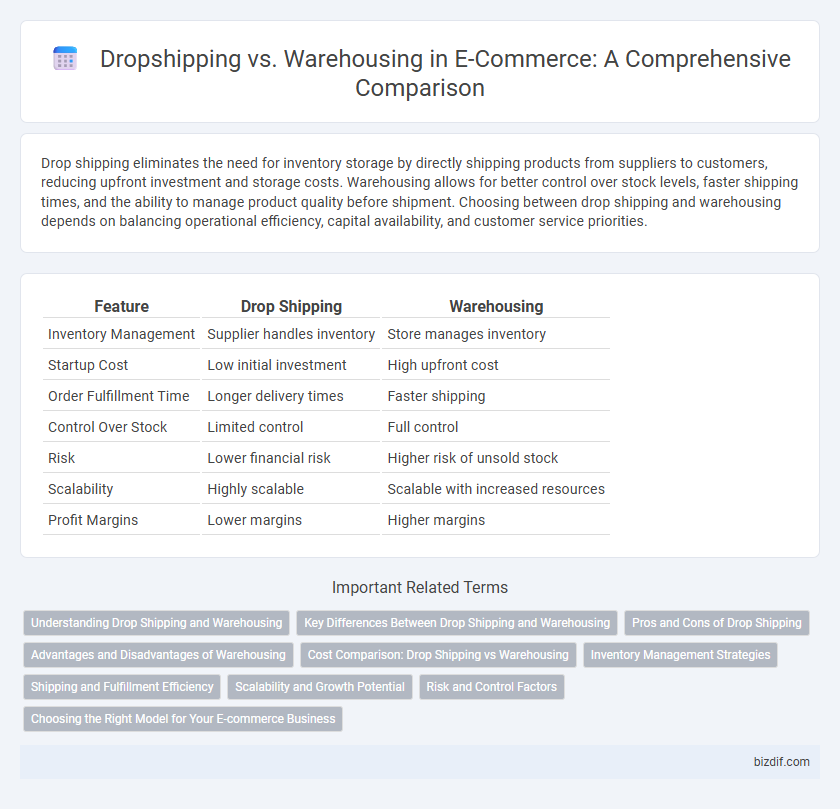Drop shipping eliminates the need for inventory storage by directly shipping products from suppliers to customers, reducing upfront investment and storage costs. Warehousing allows for better control over stock levels, faster shipping times, and the ability to manage product quality before shipment. Choosing between drop shipping and warehousing depends on balancing operational efficiency, capital availability, and customer service priorities.
Table of Comparison
| Feature | Drop Shipping | Warehousing |
|---|---|---|
| Inventory Management | Supplier handles inventory | Store manages inventory |
| Startup Cost | Low initial investment | High upfront cost |
| Order Fulfillment Time | Longer delivery times | Faster shipping |
| Control Over Stock | Limited control | Full control |
| Risk | Lower financial risk | Higher risk of unsold stock |
| Scalability | Highly scalable | Scalable with increased resources |
| Profit Margins | Lower margins | Higher margins |
Understanding Drop Shipping and Warehousing
Drop shipping enables e-commerce businesses to sell products without holding physical inventory by directly shipping orders from suppliers to customers, reducing upfront investment and storage costs. Warehousing involves maintaining stock in a physical location, offering greater control over inventory management, faster shipping times, and the ability to handle returns more efficiently. Choosing between drop shipping and warehousing depends on factors like order volume, capital availability, and desired control over the fulfillment process.
Key Differences Between Drop Shipping and Warehousing
Drop shipping involves selling products without holding physical inventory, relying on suppliers to ship directly to customers, reducing upfront costs and storage needs. Warehousing requires purchasing and storing inventory on-site or in third-party facilities, allowing greater control over stock levels and faster shipping times. Key differences include inventory management responsibilities, upfront investment, and delivery speed, impacting cash flow and customer experience in e-commerce operations.
Pros and Cons of Drop Shipping
Drop shipping allows e-commerce businesses to sell products without holding inventory, reducing upfront costs and minimizing financial risk. However, this model often results in lower profit margins and less control over shipping times and product quality, potentially impacting customer satisfaction. Relying on third-party suppliers can also lead to inventory inconsistencies and delayed order fulfillment.
Advantages and Disadvantages of Warehousing
Warehousing offers greater control over inventory management, enabling faster order fulfillment and improved product quality inspection, which enhances customer satisfaction. However, it requires significant upfront investment in storage facilities and ongoing operational costs, such as labor and utilities, impacting cash flow and scalability. Limited flexibility can hinder a business's ability to quickly adapt to market demand fluctuations compared to dropshipping models.
Cost Comparison: Drop Shipping vs Warehousing
Drop shipping eliminates upfront inventory costs by directly shipping products from suppliers to customers, reducing storage and handling expenses. Warehousing requires significant investment in renting space, managing stock, and maintaining inventory, which increases fixed operational costs. Businesses must evaluate scalability and cash flow impact when comparing the lower initial costs of drop shipping against the potential economies of scale from owning and managing a warehouse.
Inventory Management Strategies
Drop shipping relies on supplier-managed inventory, eliminating the need for upfront stock holding and reducing storage costs, but depends heavily on real-time inventory synchronization to avoid stockouts and delays. Warehousing offers direct control over inventory levels, enabling precise demand forecasting and faster order fulfillment, which enhances customer experience but requires significant capital investment and storage management. Effective inventory management strategies in e-commerce balance these models by integrating automated inventory tracking systems and leveraging data analytics to optimize stock replenishment and minimize carrying costs.
Shipping and Fulfillment Efficiency
Drop shipping eliminates the need for inventory storage, allowing faster order fulfillment by directly shipping products from suppliers to customers, reducing handling time and overhead costs. Warehousing centralizes inventory, enabling quicker processing and shipping of multiple orders with better quality control and consolidated packaging options. Efficient fulfillment in drop shipping depends heavily on supplier reliability, while warehousing provides consistent shipping speeds and enhanced control over inventory management.
Scalability and Growth Potential
Drop shipping offers unparalleled scalability by eliminating inventory management, enabling rapid expansion without significant upfront investment. Warehousing requires substantial capital and space, which can limit growth but provides greater control over inventory and shipping times. Businesses prioritizing agile growth often choose drop shipping, while those valuing control and customization typically invest in warehousing infrastructure.
Risk and Control Factors
Drop shipping minimizes inventory risk by eliminating the need to hold stock, but it sacrifices control over order fulfillment speed and product quality. Warehousing involves higher upfront investment and inventory risk but provides greater control over storage conditions, shipping times, and customer experience. Businesses must balance risk tolerance and operational control when choosing between drop shipping and warehousing for e-commerce fulfillment strategies.
Choosing the Right Model for Your E-commerce Business
Choosing the right fulfillment model between drop shipping and warehousing depends on factors such as inventory control, upfront investment, and shipping speed. Drop shipping minimizes inventory risk and capital expenditure by relying on suppliers to ship products directly to customers, making it ideal for businesses with limited resources or testing new products. Warehousing offers greater control over stock, faster delivery times, and higher profit margins, suitable for established e-commerce businesses with steady demand and the capacity to manage inventory logistics.
Drop shipping vs Warehousing Infographic

 bizdif.com
bizdif.com